
Dorado is a constellation in the Southern Sky. It was named in the late 16th century and is now one of the 88 modern constellations. Its name refers to the mahi-mahi, which is known as dorado ("golden") in Spanish, although it has also been depicted as a swordfish. Dorado contains most of the Large Magellanic Cloud, the remainder being in the constellation Mensa. The South Ecliptic pole also lies within this constellation.
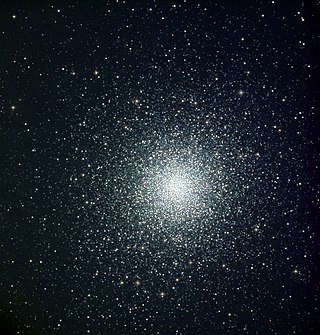
Star clusters are large groups of stars held together by self-gravitation. Two main types of star clusters can be distinguished: globular clusters are tight groups of ten thousand to millions of old stars which are gravitationally bound, while open clusters are more loosely clustered groups of stars, generally containing fewer than a few hundred members, and are often very young. Open clusters become disrupted over time by the gravitational influence of giant molecular clouds as they move through the galaxy, but cluster members will continue to move in broadly the same direction through space even though they are no longer gravitationally bound; they are then known as a stellar association, sometimes also referred to as a moving group.

The Tarantula Nebula is a large H II region in the Large Magellanic Cloud (LMC), forming its south-east corner.

NGC 1818 is a young globular cluster in the north-west part of the Large Magellanic Cloud, about 3.2 kpc from the center. It was discovered by Scottish astronomer James Dunlop in 1826, and has since been well studied.

NGC 4449, also known as Caldwell 21, is an irregular Magellanic type galaxy in the constellation Canes Venatici, being located about 13 million light-years away. It is part of the M94 Group or Canes Venatici I Group that is relatively close to the Local Group hosting our Milky Way galaxy.
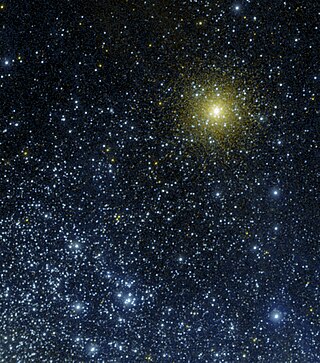
NGC 362 is a globular cluster located in the constellation Tucana in the Southern Hemisphere, slightly north of the Small Magellanic Cloud, to which it is completely unrelated. It was discovered on August 1, 1826 by James Dunlop. It is visible to the naked eye in dark skies, and is an impressive sight in a telescope, although it is somewhat overshadowed by its larger and brighter neighbour 47 Tucanae.

NGC 1806 is a globular cluster located within the Large Magellanic Cloud within the constellation of Dorado, an area of the sky best seen from the Earth's southern hemisphere. It was discovered in 1836 by the British astronomer John Herschel. At an aperture of 50 arcseconds, its apparent V-band magnitude is 11.00, but at this wavelength, it has 0.05 magnitudes of interstellar extinction.
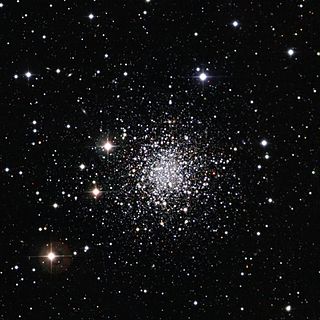
NGC 2257 is a globular cluster that lies on the outskirts of the Large Magellanic Cloud (LMC). It was discovered in 1834 by John Herschel. The compiler of the New General Catalogue, John Louis Emil Dreyer, described this cluster as "faint, considerably large, round, very gradually a little brighter middle, mottled but not resolved, 17.0 seconds of time diameter." At an aperture of 30.5 arcseconds, its apparent V-band magnitude is 12.62, but at this wavelength, it has 0.12 magnitudes of interstellar extinction.

NGC 1868 is a globular cluster in the Large Magellanic Cloud in the constellation Dorado. It was discovered by John Herschel in 1834. The cluster is fairly metal-poor and as a result appears relatively blue. It maintains an abundant population of mature giant branch stars which have been used to fit its age to roughly 700 million years old. The cluster is located in a relatively sparse region of the Large Magellanic Cloud which has allowed it to be studied relatively free of crowding from background stars.

NGC 1783 is a globular cluster within the Dorado constellation and part of the Large Magellanic Cloud, a satellite dwarf galaxy of the Milky Way. At an aperture of 50 arcseconds, its apparent V-band magnitude is 10.39, making it one of the brightest globular clusters in the LMC as viewed from Earth. It was discovered in 1835 by John Herschel. The compiler of the New General Catalogue, John Louis Emil Dreyer, described this cluster as "considerably bright, large, round, very gradually pretty much brighter middle, mottled but not resolved."

NGC 121 is a globular cluster in the Small Magellanic Cloud, in the constellation of Tucana. It was first discovered by John Herschel on September 20, 1835. The compiler of the New General Catalogue, John Louis Emil Dreyer, described this object as "pretty bright, pretty small, little extended, very gradually brighter middle".

NGC 1854 is a young globular cluster in the northern part of the central bar structure of the Large Magellanic Cloud in the Dorado constellation. At 200x magnification the cluster appears very bright, large and round, with dozens of very faint stars visible. NGC 1858, a nebula/star cluster object, lies to the south-east.

NGC 1755 is an open star cluster in the Large Magellanic Cloud in the Dorado constellation. It is about 120 light years across and due to its size could be a globular cluster. It has a diameter of 2.6′ and an apparent magnitude of 9.9. It was discovered by James Dunlop in 1826.

NGC 330 is an open cluster in the Small Magellanic Cloud. It is located in the constellation Tucana. It was discovered on 1 August 1826 by James Dunlop. It was described by Dreyer as "a globular cluster, very bright, small, a little extended, stars from 13th to 15th magnitude." At an aperture of 31.0 arcseconds, the apparent V-band magnitude is 9.60, but at this wavelength, it also has 0.36 magnitudes of interstellar extinction.

NGC 1466 is the New General Catalogue designation for a globular cluster in the deep southern constellation of Hydrus. It is located in the outskirts of the Large Magellanic Cloud, which is a satellite galaxy of the Milky Way. The object was discovered November 26, 1834 by English astronomer John Herschel. John Dreyer described it as "pF, pS, iR, glbM, *7 f", meaning "pretty faint, pretty small, irregular round, gradually a little brighter middle, with a 7th magnitude star nearby". When using a small telescope, this is a "faint, small, unresolved and difficult" target with an angular size of 1.9 arc minutes. It has an integrated visual magnitude of 11.4.

NGC 1846 is a globular cluster containing hundreds of thousands of stars in the outer halo of the Large Magellanic Cloud. It was discovered on November 6, 1826, by James Dunlop and is included in the New General Catalogue. At an aperture of 50 arcseconds, its apparent V-band magnitude is 10.68, but at this wavelength, it has 0.07 magnitudes of interstellar extinction.
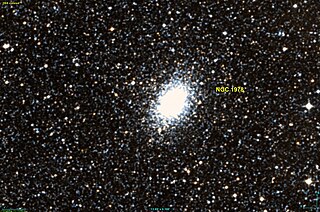
NGC 1978 is an elliptical shaped globular cluster or open cluster in the constellation Dorado. It is located within the Large Magellanic Cloud. It was discovered by James Dunlop on November 6, 1826. At an aperture of 50 arcseconds, its apparent V-band magnitude is 10.20, but at this wavelength, it has 0.16 magnitudes of interstellar extinction. It appears 3.9 arcminutes wide. NGC 1978 has a radial velocity of 293.1 ± 0.9 km/s.

NGC 1987 is an open cluster or a globular cluster located in the Mensa constellation and part of the Large Magellanic Cloud. It was discovered by John Herschel on November 3, 1834. Its apparent magnitude is 12.1, and its size is 1.7 arc minutes. It is thought to be around 600 million years old and has a significant number of red ageing stars.
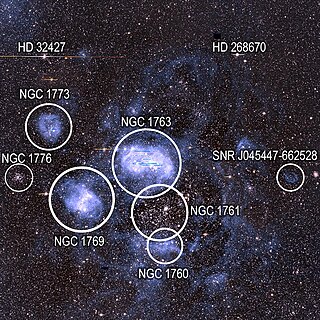
N11 is the brightest emission nebula in the north-west part of the Large Magellanic Cloud in the Dorado constellation. The N11 complex is the second largest H II region of that galaxy, the largest being the Tarantula Nebula. It covers an area approximately 6 arc minutes across. It has an elliptical shape and consists of a large bubble, generally clear interstellar area, surrounded by nine large nebulae. It was named by Karl Henize in 1956.

NGC 1898 is a globular cluster in the constellation of Dorado at an approximate distance of 170,000 light-years. NGC 1898 is located in the Large Magellanic Cloud, a satellite galaxy of the Milky Way, and was for some time believed to be discovered by John Herschel in 1834; however recent research shows it was first observed by James Dunlop in 1826.





















